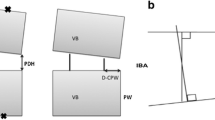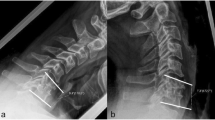Abstract
Subsidence of interbody cages is a frequently observed and relevant complication in anterior cervical discectomy and fusion (ACDF). Only a handful of studies concentrated on the modality of subsidence and its clinical impact. We performed a retrospective analysis of ACDF patients from 2004 to 2010. Numeric analog scale (NAS) score pre-op and post-op, Oswestry Disability Index (ODI) on x-rays, endplate (EP) and cage dimensions, implant position, lordotic/kyphotic subsidence patterns (>5°), and cervical alignment were recorded. Subsidence was defined as height loss >40%. Patients were grouped into single segment (SS), double segment (DS), and plated procedures. We included 214 patients. Prevalence of subsidence was 44.9% overall, 40.9% for SS, and 54.8% for DS. Subsidence presented mostly for dorsal (40.7%) and mid-endplate position (46.3%, p < 0.01); dorsal placement resulted in kyphotic (73.7%) and central placement in balanced implant migration (53.3%, p < 0.01). Larger cages (>65% EP) showed less subsidence (64.6 vs. 35.4%, p < 0.01). There was no impact of subsidence on ODI or alignment. NAS was better for subsided implants in SS (p = 0.06). Cages should be placed at the anterior endplate rim in order to reduce the risk of subsidence. Spacers should be adequately sized for the respective segment measuring at least 65% of the segment dimensions. The cage frame should not rest on the vulnerable central endplate. For multilevel surgery, ventral plating may be beneficial regarding construct stability. The reduction of micro-instability or over-distraction may explain lower NAS for subsided implants.






Similar content being viewed by others
References
Bai J, Zhang X, Zhang D, Ding W, Shen Y, Zhang W, Du M (2015) Impact of over distraction on occurrence of axial symptom after anterior cervical discectomy and fusion. Int J Clin Exp Med 8:19746–19756
Balabhadra RS, Kim DH, Zhang HY (2004) Anterior cervical fusion using dense cancellous allografts and dynamic plating. Neurosurgery 54:1405–1411 discussion 1411-1402
Barsa P, Suchomel P (2007) Factors affecting sagittal malalignment due to cage subsidence in standalone cage assisted anterior cervical fusion. European spine journal : official publication of the European Spine Society, the European Spinal Deformity Society, and the European Section of the Cervical Spine Research Society 16:1395–1400. doi:10.1007/s00586-006-0284-8
Brenke C, Dostal M, Scharf J, Weiss C, Schmieder K, Barth M (2014) Influence of cervical bone mineral density on cage subsidence in patients following stand-alone anterior cervical discectomy and fusion. European spine journal : official publication of the European Spine Society, the European Spinal Deformity Society, and the European Section of the Cervical Spine Research Society. doi:10.1007/s00586-014-3725-9
Cavusoglu H, Turkmenoglu O, Kaya RA, Can SM, Aydin Y (2006) Effects of anterior contralateral cervical microdiskectomy on radiological and clinical outcome. Surg Neurol 65:446–452 . doi:10.1016/j.surneu.2005.07.071 discussion 453
Fairbank JC, Pynsent PB (2000) The Oswestry Disability Index. Spine 25:2940–2952 discussion 2952
Haden N, Latimer M, Seeley HM, Laing RJ (2005) Loss of inter-vertebral disc height after anterior cervical discectomy. Br J Neurosurg 19:469–474. doi:10.1080/02688690500495109
Harrison DE, Harrison DD, Cailliet R, Troyanovich SJ, Janik TJ, Holland B (2000) Cobb method or Harrison posterior tangent method: which to choose for lateral cervical radiographic analysis. Spine 25:2072–2078
Joung YI, Oh SH, Ko Y, Yi HJ, Lee SK (2007) Subsidence of cylindrical cage (AMSLUtrade mark cage) : postoperative 1 year follow-up of the cervical anterior interbody fusion. Journal of Korean Neurosurgical Society 42:367–370. doi:10.3340/jkns.2007.42.5.367
Kao TH, Wu CH, Chou YC, Chen HT, Chen WH, Tsou HK (2014) Risk factors for subsidence in anterior cervical fusion with stand-alone polyetheretherketone (PEEK) cages: a review of 82 cases and 182 levels. Arch Orthop Trauma Surg 134:1343–1351. doi:10.1007/s00402-014-2047-z
Karikari IO, Jain D, Owens TR, Gottfried O, Hodges TR, Nimjee SM, Bagley CA (2014) Impact of subsidence on clinical outcomes and radiographic fusion rates in anterior cervical discectomy and fusion: a systematic review. J Spinal Disord Tech 27:1–10. doi:10.1097/BSD.0b013e31825bd26d
Klingler JH, Kruger MT, Sircar R, Kogias E, Scholz C, Volz F, Scheiwe C, Hubbe U (2014) PEEK cages versus PMMA spacers in anterior cervical discectomy: comparison of fusion, subsidence, sagittal alignment, and clinical outcome with a minimum 1-year follow-up. TheScientificWorldJOURNAL 2014:398396. doi:10.1155/2014/398396
Lee CH, Hyun SJ, Kim MJ, Yeom JS, Kim WH, Kim KJ, Jahng TA, Kim HJ, Yoon SH (2013) Comparative analysis of 3 different construct systems for single-level anterior cervical discectomy and fusion: stand-alone cage, iliac graft plus plate augmentation, and cage plus plating. J Spinal Disord Tech 26:112–118. doi:10.1097/BSD.0b013e318274148e
Lee CH, Kim KJ, Hyun SJ, Yeom JS, Jahng TA, Kim HJ (2015) Subsidence as of 12 months after single-level anterior cervical inter-body fusion. Is it related to clinical outcomes? Acta Neurochir 157:1063–1068. doi:10.1007/s00701-015-2388-6
Lee YS, Kim YB, Park SW (2014) Risk factors for postoperative subsidence of single-level anterior cervical discectomy and fusion: the significance of the preoperative cervical alignment. Spine 39:1280–1287. doi:10.1097/brs.0000000000000400
Li J, Li Y, Kong F, Zhang D, Zhang Y, Shen Y (2015) Adjacent segment degeneration after single-level anterior cervical decompression and fusion: disc space distraction and its impact on clinical outcomes. Journal of clinical neuroscience : official journal of the Neurosurgical Society of Australasia 22:566–569. doi:10.1016/j.jocn.2014.08.019
Martin GJ Jr, Haid RW Jr, MacMillan M, Rodts GE Jr, Berkman R (1999) Anterior cervical discectomy with freeze-dried fibula allograft. Overview of 317 cases and literature review. Spine 24:852–858 discussion 858-859
Matge G (2002) Cervical cage fusion with 5 different implants: 250 cases. Acta Neurochir 144:539–549 . doi:10.1007/s00701-002-0939-0 discussion 550
Oh JK, Kim TY, Lee HS, You NK, Choi GH, Yi S, Ha Y, Kim KN, Yoon DH, Shin HC (2013) Stand-alone cervical cages versus anterior cervical plate in 2-level cervical anterior interbody fusion patients: clinical outcomes and radiologic changes. J Spinal Disord Tech 26:415–420. doi:10.1097/BSD.0b013e31824c7d22
Shiban E, Gapon K, Wostrack M, Meyer B, Lehmberg J (2016) Clinical and radiological outcome after anterior cervical discectomy and fusion with stand-alone empty polyetheretherketone (PEEK) cages. Acta Neurochir 158:349–355. doi:10.1007/s00701-015-2630-2
Smith GW, Robinson RA (1958) The treatment of certain cervical-spine disorders by anterior removal of the intervertebral disc and interbody fusion. The Journal of bone and joint surgery American 40-a:607–624
Tome-Bermejo F, Morales-Valencia JA, Moreno-Perez J, Marfil-Perez J, Diaz-Dominguez E, Pinera AR, Alvarez L (2015) Long-term changes in sagittal alignment and its clinical implications after cervical interbody fusion cage subsidence for degenerative cervical disc disease. A prospective study with standalone lordotic tantalum cages. J Spinal Disord Tech. doi:10.1097/BSD.0000000000000293
Wu WJ, Jiang LS, Liang Y, Dai LY (2012) Cage subsidence does not, but cervical lordosis improvement does affect the long-term results of anterior cervical fusion with stand-alone cage for degenerative cervical disc disease: a retrospective study. European spine journal : official publication of the European Spine Society, the European Spinal Deformity Society, and the European Section of the Cervical Spine Research Society 21:1374–1382. doi:10.1007/s00586-011-2131-9
Yamagata T, Takami T, Uda T, Ikeda H, Nagata T, Sakamoto S, Tsuyuguchi N, Ohata K (2012) Outcomes of contemporary use of rectangular titanium stand-alone cages in anterior cervical discectomy and fusion: cage subsidence and cervical alignment. Journal of clinical neuroscience : official journal of the Neurosurgical Society of Australasia 19:1673–1678. doi:10.1016/j.jocn.2011.11.043
Zajonz D, Franke AC, von der Hoh N, Voelker A, Moche M, Gulow J, Heyde CE (2014) Is the radiographic subsidence of stand-alone cages associated with adverse clinical outcomes after cervical spine fusion? An observational cohort study with 2-year follow-up outcome scoring. Patient safety in surgery 8:43. doi:10.1186/s13037-014-0043-4
Author information
Authors and Affiliations
Corresponding author
Ethics declarations
In accordance with local and institutional laws and data protection regulations, no approval by the local ethics committee was necessary for this retrospective study. The study was performed in accordance with the ethical standards laid down in the 1964 Declaration of Helsinki and its later amendments.
Funding
No funding was received for this research.
Conflict of interest
All authors certify that they have no affiliations with or involvement in any organization or entity with any financial interest (such as honoraria; educational grants; participation in speakers’ bureaus; membership, employment, consultancies, stock ownership, or other equity interest; and expert testimony or patent-licensing arrangements) or non-financial interest (such as personal or professional relationships, affiliations, knowledge, or beliefs) in the subject matter or materials discussed in this manuscript.
Ethical approval
For this type of study, formal consent is not required.
Additional information
The content of this manuscript has in part been presented as an oral presentation at the Spine Section Meeting of the German Society of Neurosurgery in Berlin 3rd October 2015.
Rights and permissions
About this article
Cite this article
Mende, K., Eicker, S. & Weber, F. Cage deviation in the subaxial cervical spine in relation to implant position in the sagittal plane. Neurosurg Rev 41, 267–274 (2018). https://doi.org/10.1007/s10143-017-0850-z
Received:
Revised:
Accepted:
Published:
Issue Date:
DOI: https://doi.org/10.1007/s10143-017-0850-z




